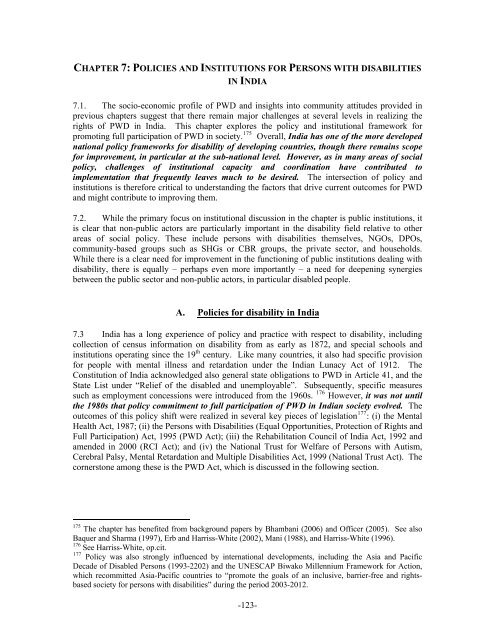People with Disabilities in India: From Commitment to Outcomes
People with Disabilities in India: From Commitment to Outcomes
People with Disabilities in India: From Commitment to Outcomes
You also want an ePaper? Increase the reach of your titles
YUMPU automatically turns print PDFs into web optimized ePapers that Google loves.
CHAPTER 7: POLICIES AND INSTITUTIONS FOR PERSONS WITH DISABILITIES<br />
IN INDIA<br />
7.1. The socio-economic profile of PWD and <strong>in</strong>sights <strong>in</strong><strong>to</strong> community attitudes provided <strong>in</strong><br />
previous chapters suggest that there rema<strong>in</strong> major challenges at several levels <strong>in</strong> realiz<strong>in</strong>g the<br />
rights of PWD <strong>in</strong> <strong>India</strong>. This chapter explores the policy and <strong>in</strong>stitutional framework for<br />
promot<strong>in</strong>g full participation of PWD <strong>in</strong> society. 175 Overall, <strong>India</strong> has one of the more developed<br />
national policy frameworks for disability of develop<strong>in</strong>g countries, though there rema<strong>in</strong>s scope<br />
for improvement, <strong>in</strong> particular at the sub-national level. However, as <strong>in</strong> many areas of social<br />
policy, challenges of <strong>in</strong>stitutional capacity and coord<strong>in</strong>ation have contributed <strong>to</strong><br />
implementation that frequently leaves much <strong>to</strong> be desired. The <strong>in</strong>tersection of policy and<br />
<strong>in</strong>stitutions is therefore critical <strong>to</strong> understand<strong>in</strong>g the fac<strong>to</strong>rs that drive current outcomes for PWD<br />
and might contribute <strong>to</strong> improv<strong>in</strong>g them.<br />
7.2. While the primary focus on <strong>in</strong>stitutional discussion <strong>in</strong> the chapter is public <strong>in</strong>stitutions, it<br />
is clear that non-public ac<strong>to</strong>rs are particularly important <strong>in</strong> the disability field relative <strong>to</strong> other<br />
areas of social policy. These <strong>in</strong>clude persons <strong>with</strong> disabilities themselves, NGOs, DPOs,<br />
community-based groups such as SHGs or CBR groups, the private sec<strong>to</strong>r, and households.<br />
While there is a clear need for improvement <strong>in</strong> the function<strong>in</strong>g of public <strong>in</strong>stitutions deal<strong>in</strong>g <strong>with</strong><br />
disability, there is equally – perhaps even more importantly – a need for deepen<strong>in</strong>g synergies<br />
between the public sec<strong>to</strong>r and non-public ac<strong>to</strong>rs, <strong>in</strong> particular disabled people.<br />
A. Policies for disability <strong>in</strong> <strong>India</strong><br />
7.3 <strong>India</strong> has a long experience of policy and practice <strong>with</strong> respect <strong>to</strong> disability, <strong>in</strong>clud<strong>in</strong>g<br />
collection of census <strong>in</strong>formation on disability from as early as 1872, and special schools and<br />
<strong>in</strong>stitutions operat<strong>in</strong>g s<strong>in</strong>ce the 19 th century. Like many countries, it also had specific provision<br />
for people <strong>with</strong> mental illness and retardation under the <strong>India</strong>n Lunacy Act of 1912. The<br />
Constitution of <strong>India</strong> acknowledged also general state obligations <strong>to</strong> PWD <strong>in</strong> Article 41, and the<br />
State List under “Relief of the disabled and unemployable”. Subsequently, specific measures<br />
such as employment concessions were <strong>in</strong>troduced from the 1960s. 176 However, it was not until<br />
the 1980s that policy commitment <strong>to</strong> full participation of PWD <strong>in</strong> <strong>India</strong>n society evolved. The<br />
outcomes of this policy shift were realized <strong>in</strong> several key pieces of legislation 177 : (i) the Mental<br />
Health Act, 1987; (ii) the Persons <strong>with</strong> <strong>Disabilities</strong> (Equal Opportunities, Protection of Rights and<br />
Full Participation) Act, 1995 (PWD Act); (iii) the Rehabilitation Council of <strong>India</strong> Act, 1992 and<br />
amended <strong>in</strong> 2000 (RCI Act); and (iv) the National Trust for Welfare of Persons <strong>with</strong> Autism,<br />
Cerebral Palsy, Mental Retardation and Multiple <strong>Disabilities</strong> Act, 1999 (National Trust Act). The<br />
corners<strong>to</strong>ne among these is the PWD Act, which is discussed <strong>in</strong> the follow<strong>in</strong>g section.<br />
175 The chapter has benefited from background papers by Bhambani (2006) and Officer (2005). See also<br />
Baquer and Sharma (1997), Erb and Harriss-White (2002), Mani (1988), and Harriss-White (1996).<br />
176 See Harriss-White, op.cit.<br />
177 Policy was also strongly <strong>in</strong>fluenced by <strong>in</strong>ternational developments, <strong>in</strong>clud<strong>in</strong>g the Asia and Pacific<br />
Decade of Disabled Persons (1993-2202) and the UNESCAP Biwako Millennium Framework for Action,<br />
which recommitted Asia-Pacific countries <strong>to</strong> “promote the goals of an <strong>in</strong>clusive, barrier-free and rightsbased<br />
society for persons <strong>with</strong> disabilities” dur<strong>in</strong>g the period 2003-2012.<br />
-123-










